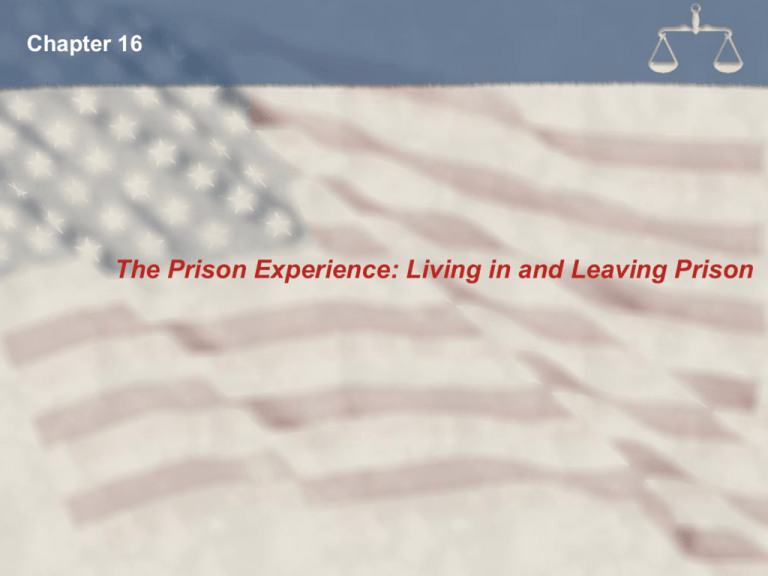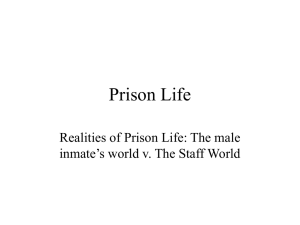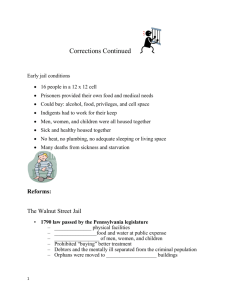Prisoner Rights
advertisement

Chapter 16 The Prison Experience: Living in and Leaving Prison When Were Prisons Built? 25 before 1875 79 between 1875 - 1924 141 between 1925 - 1949 First built were Auburn and Elmira which are still used Adjusting to Prison Life Finding a coping style Loner Joining a gang or group Hustling to maintain some power Being politically savvy The “New” Inmate Culture Black Power movement Black and Latin inmates more organized Racial polarity and tension is a dominant force Groups form because of: Religious or political affiliations To combat discrimination Previous street gang membership Women in Prison: Female Institutions Few institutions built before 1960 Four built between 1930 - 1950 Thirty-four built during 1980s Women in Prison: The Nature of Institutions Overcrowding Smaller than male institutions Many are minimum security Some similar to college dorms Many lack treatment programs Female Inmates Female inmates are: Young Minority group members Unmarried Undereducated Either unemployed or underemployed Have had a troubled family lives Are more likely than males to be convicted of a non-violent crime and be incarcerated for a low-level involvement in a drug crime Display psychological problems including serious psychopathology Likely to have had a substance abuse problem Women in Prison: The Female Subculture Nonviolent to staff Lack anti-authority inmate social code Direct anger inward Self-mutilation (“carving”) Make-believe families Institutional Treatment Programs: General Types Individual therapy Group therapy Educational training Vocational training Special-Needs Inmates Variety of problems: Mental problems Physical disability problems Infectious diseases Elderly Special treatment programs and facilities may be needed Elderly Inmates A study of elderly inmates found: The proportion of state and federal inmates 55 years of age and older is steadily increasing. Those over 75 will increase if current sentencing strategies remain in place. Most were unmarried white males with children who did not graduate from high school. Most were likely to be incarcerated for violent crime, often against a family member. They are more likely to report one or more chronic health problems. Most states and the Federal Bureau of Prisons have implemented limited provisions to accommodate older inmates with special needs. Education and Vocational Programs First programs were educational Most common opportunity is for a GED or HS diploma Some provide college level education Problems of delivery require innovative approaches to educational programs Basic Prison Industries Food services Maintenance Laundry Agriculture Criticisms of Vocational Programs Inmates have trouble finding work after release Training equipment is second-hand Real purpose is prison upkeep and maintenance, not prisoner preparation Unions and others resent prison labor being dumped into the labor pool after release Work Release May supplement training/education May live in institution at night, work in community during day Some live and work in the community Some community-based facilities also operate as a pre-release center While some critics want to end work release, the program is supported by the ACLU Prison Industries Contract system Convict lease system State Use Model Demise of Prison Industries Organized labor unions oppose forced labor (unfair competition) Sumners-Ashurst Act (1940): federal offense to transport interstate commerce goods made in prison for private use Prison Rules: Violation Penalties Loss of good time Solitary confinement Suspension of privileges Transfer to more secure facility Treatment Problems Lack of funds, facilities and qualified personnel Duality of correctional officers’ role Inmate Conflict Inmate violence (inmate against inmate) Average 70 incidents/year/institution Homosexual rape Non-sexual assault (shake down) Prison riots (90% of all riots have taken place since 1952) Causes of Prison Violence Inmates are violence prone Prisons convert people to violence - “survival mentality” Prison mismanagement Overcrowding Collective Violence in Prison There are two distinctive theories of the cause of collective violence: The inmate-balance theory suggests that riots and other forms of collective action occur when prison officials make an abrupt effort to take control of the prison and limit freedoms. The administrative-control theory of collective violence suggests that it is explained by prison management, lack of strong security, and inadequate control by prison officials. Contemporary Technocorrections Ground penetrating radar Heartbeat monitoring Satellite monitoring Pulsed radar Sticky shocker Backscatter imaging system for concealed weapons Body scanning screening system Contemporary Technocorrections (cont.) Personal health status monitor All-in-one drug detection spray Radar vital signs monitor/radar flashlight Personal alarm location system Others not yet in use include: Angel chip Noninvasive body cavity scanner (MRI) Noninvasive drug detection Hands-off Doctrine The judicial policy of not interfering in the administrative affairs of prisons Justifications include: Correctional administration was a technical matter best left to experts rather than the courts Society as a whole was apathetic to what went on in prisons Prisoners’ complaints involved privileges rather than rights Prisoner Rights: Access to Courts and Legal Services Inmates are entitled to have legal materials available Inmates are entitled to have assistance in drawing up and filing complaints Important Cases About the Access to Courts and Legal Services DeMallory v. Cullen (1988) – An untrained inmate paralegal is not equivalent alternative to law library access. Lindquist v. Idaho State Board of Corrections (1985) – Seven inmate law clerks for a prison population of 950 was sufficient because they had a great deal of experience. Smith v. Wade (1983) – An inmate who has been raped can have access to the state court to sue. Bounds v. Smith (1977) – State correctional systems are obligated to provide inmates with either adequate law libraries or the help of people trained in the law. Important Cases in the Freedom of Press and Expression Turner v. Safley (1987) – Prisoners do not have the right to receive mail from one another. Ramos v. Lamm (1980) – The institutional policy of refusing to deliver mail in a language other than English is unconstitutional. Procunier v. Martinez (1974) - Censorship of a prisoner’s mail is justified only when: (A) There exists substantial government interest in maintaining the censorship to further prison security, order, and rehabilitation, and (B) The restrictions are not greater or more stringent than is demanded by security precautions. Nolan v. Fitzpatrick (1971) – Prisoners may correspond with newspapers unless their letters discuss escape plans or contain contraband or otherwise objectionable material. Prisoner Rights: Freedom of Religion First Amendment protection Inmates have the right to assemble and pray Religious symbols and practices may be restricted if they interfere with security Special privileges can be denied Important Cases About the Freedom of Religion Mumin v. Phelps (1988) – Inmates can be denied special privileges to attend religious services if there is a legitimate penological interest. O’Lone v. Estate of Shabazz (1987) – Prison officials can assign inmates work schedules that make it impossible for them to attend religious services as long as no reasonable alternative exists. Rahman v. Stephenson (1986) – A prisoner’s rights are not violated if the administration refuses to use the prisoner’s religious name on official records. Prisoner Rights: Medical Rights Past policy was to restrict medical rights through the “exceptional circumstances doctrine” Estelle v. Gamble Use deliberate indifference standard to mandate inmate’s right to medical care Prisoner Rights: Cruel and Unusual Punishment Degrades human dignity More severe than the offense Shocks the conscience Is deliberately indifferent to a person’s safety and well-being Punishes people because of their status, such as race, religion, and mental state Is in flagrant disregard of due process of law, such as punishment that is capriciously applied Parole The most common means of release from prison Approximately 15% serve the full sentence Very few get commutations Almost 7,000 escape each year Parole Boards Usually independent state agency Members are appointed Usually no professional statutory qualifications for membership Primary Functions of Parole Boards To select and place prisoners on parole To supervise parolees in the community To determine when parole is complete and discharge parolees To determine if parole revocation should take place Parole Hearings Discretionary parole is made at a parole hearing. Inmates rights at the hearing vary from jurisdiction to jurisdiction. Information considered by the parole board in making its decision includes: Police reports of the crime Presentence investigation report Psychological testing and scores developed by prison mental health professionals Institutional reports of disciplinary actions, treatment and adjustment Letters may be solicited from inmate’s family and friends Victims may appear and make statements about losses they have suffered Conditions of Parole Rules fall into two categories: General rules required of all parolees Specific rules applied to an individual case Rules may prohibit some types of behavior and demand others Violation of rules may lead to parole being revoked Recidivism: A Traditional Measure of ParoleEffectiveness What is recidivism? The definition can vary. Is it: Those who commit another crime of any kind? Those who commit the same type of crime? Those whocommit crime within a certain time period? The Problems of Re-entry The very nature of the prison experience may cause problems: Dehumanizing Separation from family and friends Lifelong personal deficits Return to neighborhoods and social interaction with others that prompted law-violating behavior in the first place The Fortune Society helps prisoners break the cycle of incarceration.






